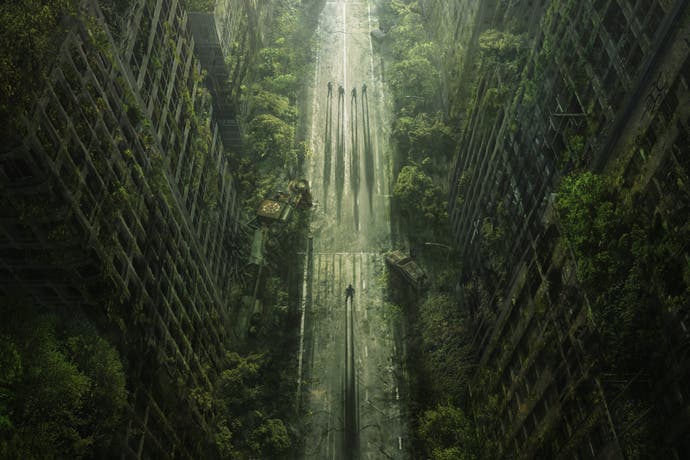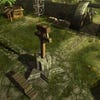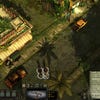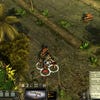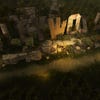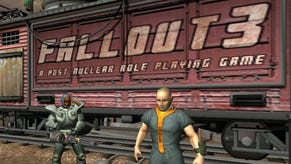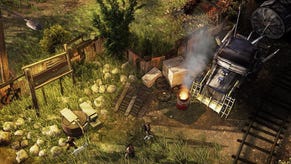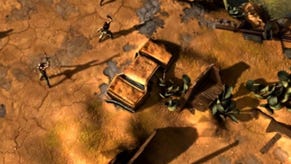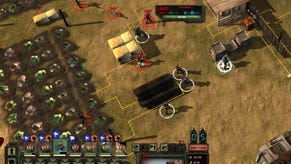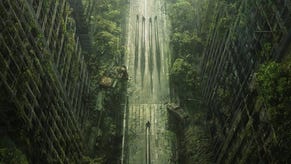The long journey of Wasteland 2
After 26 years in the wilderness the grandfather of post-apocalyptic role-playing returns.
In late 2011, while on a business trip to Singapore, Brian Fargo gave a presentation to a room full of people about old-school role-playing games. As founder of Interplay, he'd worked on many: Baldur's Gate, Planescape: Torment, Fallout 1 and 2. He had a lot to say.
The talk felt like a post-mortem. A lament. As a commercial exercise old school role-playing games were dead, he'd decided. But remembering what made them great was fun, in a warm, fuzzy, nostalgic kind of way.
Fast forward three years, and old school role-playing games are back with a bang. Larian's Divinity: Original Sin is still one of the top selling games on Steam a month after release, and players are loving it. There's huge excitement for Obsidian's Pillars of Eternity, the spiritual successor to Baldur's Gate, and of course inXile's Wasteland 2, the sequel to the grandfather of post-apocalyptic role-playing games and the precursor to the Fallout series.
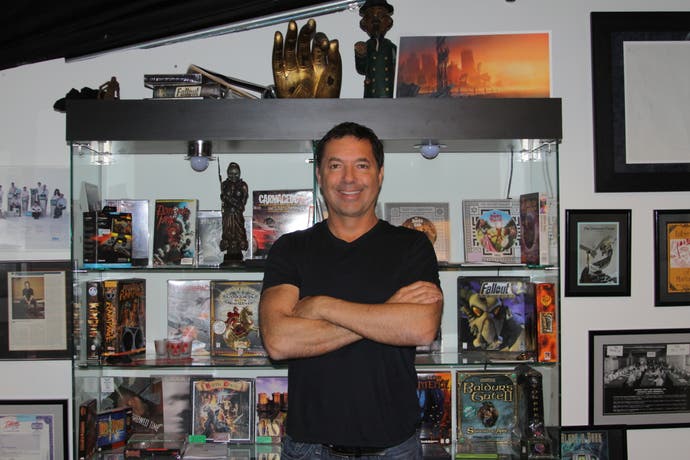
Fargo, founder of California developer inXile, remembers that presentation in Singapore. It came after eight long years spent pitching Wasteland 2 to publishers. In all that time he'd failed to get a single second meeting. Even earlier he'd spent a decade trying to wrestle the Wasteland 2 trademark away from those who sought to sit on it. The talk in Singapore felt like a resignation. "At that point I was done pitching publishers, period," he says. Despite being sure there was an audience for it, Wasteland 2 was, effectively, dead.
And it didn't look good for inXile, either. Fargo had just about emerged unscathed from the development and launch of the console-focused action role-playing game Hunted: The Demon's Forge for publisher Bethesda. But the turbulent, stressful project left its mark. Hunted failed to set tills alight, and inXile had shrunk down from 60 staff to just 12. Back catalogue sales from the likes of The Bard's Tale, Line Rider and The Impossible Quiz were not enough to sustain payroll. Things looked bleak.
Then Tim Schafer changed everything.
On 9th February 2012 Schafer launched a Kickstarter for what was then called Double Fine Adventure, an old-school point and click adventure game that rekindled memories of LucasArts classics such as The Secret of Monkey Island. Schafer asked for $400,000.
Fargo saw the money flood into Double Fine Adventure and, the next day, decided he'd try the same thing for Wasteland 2, the game he'd declared in his mind dead and buried. "I said, this is it," he remembers. "This is our shot."
Fargo and inXile immediately began working on what would become the Wasteland 2 Kickstarter page, and on 13th March 2012 - the day before Double Fine Adventure's Kickstarter closed to the tune of $3.3m - set it live with a pitch video that remains one of the most effective in video game crowdfunding history. It's a sketch, really, that sends up the meetings he used to have with publishers about Wasteland 2. It's in the video below.
Fargo asked for $900,000, which was more than double Schafer had asked for. He'd been told that was too much, so he said he'd put in $100,000 of his own money, raising the total to $1m, if Wasteland 2 hit its target. He was also told Schafer's success was a one-off and lightning would not strike twice. "There was no lack of nervousness the night before," he says. "It was like opening a broadway show." Undeterred, Fargo pressed the big red button and off the Kickstarter went.
"The first day I told people, 'whatever you do, don't even tell me the number.' I said, 'I don't want to know it. I'll look at it in the morning.' Everything was on the line. Where was the company going to go? Who would have picked up a Wasteland 2 after it had failed on Kickstarter? Then the publishers would go, 'see, I told you.' I was ready for that."
By the end of the first day Wasteland 2 had raised $400,000 - nearly half its goal. "I thought, the next day it's going to drop off into a trough and we'll be lucky to make the $900,000." The next day, though, started strong, then something crazy happened. A "random guy" contacted the studio. He was one of Wasteland 2's $10,000 backers. He said if inXile came up short, he'd give them the rest of the money.
"We were half a million short at the time. I almost got teary-eyed. I thought, we're going to make it. If I've got a guy saying that, we're going to make it."
43 hours after the Wasteland 2 Kickstarter launched it was funded. Fargo was at inXile's office outside Los Angeles at the time. The team was "doing a little jig" he says. "It was like a New Year's Eve countdown. The first 10 years I couldn't even get the trademark. Then another eight years of hardcore pitching getting nowhere. It was a great moment."
The mysterious $10,000 benefactor didn't need to get his wallet out in the end, but who was he? He doesn't want his identity to be known, Fargo says, tightlipped. But he is, apparently, one of the early founders of a "huge" electronics business who "made a killing". "A local guy," Fargo smiles. "He's been to my office a couple of times. Nice guy."
In total 12 people gave Wasteland 2 $10,000 each, and inXile has thanked them all. One said he had pirated all of Fargo's games as a kid so felt bad. Another gave $10,000 to Wasteland 2 and $10,000 for Torment, inXile's later, even more successful Kickstarter. The latter turned up at the Torment closing party, driving down from San Francisco. Fargo couldn't help himself. "I said, 'I'm just curious. I think it's fantastic, and thank you! But, what makes you want to step up like that?' He says, 'I like games.'"
On 17th April 2012 the Wasteland 2 Kickstarter ended having raised an incredible $2.9m. With PayPal contributions and Fargo's $100,000 the total generated through crowdfunding was a few hundred thousand over $3m.
"It was amazing to me," Fargo recalls. "When you do contracts they come from anywhere but trust. You have 10 pages of pain about how to get paid. What happens if you're not on time? They could take your project away from you. They could take your trademark. They could shut down your company. They could take over your company. They could sue your company. You can have damages that are related not just to that but to their stock market price dropping. You can be on the hook literally for a billion dollars for screwing up a contract. I came from that world to, 'here's the money up front, Brian. We trust you.' What a difference."
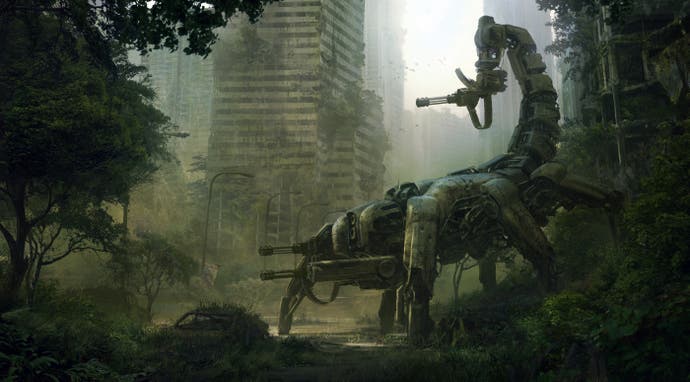
Of course, then the real hard work began. With the weight of expectation from over 60,000 backers bearing down hard on Fargo and his team, he immediately began hiring and putting together a vision document, one that gave the developers an outline of the kind of game Wasteland 2 had to be.
It wasn't heavy on the detail. Instead, it spelled out what from the ancient original had to stay and what from modern gaming had to go in. Turn-based party-based combat, cause and effect, humour, reading (lots of reading) - all the good stuff that made the role-playing games of the golden age, as Fargo calls it, what they were, fused with better visuals and modern sensibilities.
If you're making a game that only exists because people have funded its development, then that development must be transparent. This was an alien way of working for inXile, which had for the large part made games for publishers as a work for hire studio. The publisher would dictate how the developer would communicate to gamers, restricting appearances to PR events, game shows and slick videos. With Wasteland 2, inXile was, for the first time, exposed.
"Finally development is a spectator sport," Fargo says. "People were watching every decision we made. There are some things you can throw out to the crowd, like the user interface, and they'll give you feedback. When we said we were using the Unity engine, a lot of people said, 'are you kidding me? That's only used for browser and mobile games.' I said, 'well, hold on a second. There's more to it here.' We had to make decisions. Some were popular. Some were unpopular."
The DNA of the company had to be adjusted to cope with putting parts of the game into the wild much earlier than the developers were used to, and then to seek feedback at every step of the way, listening objectively, all the while trying to stay true to the vision document. It was tough, Fargo admits.
And, of course, alongside all of that, inXile experienced the traditional rigours of game development: heated debate over features, assets and, crucially, size and scope. Deciding on the scope, Fargo says, was the hardest thing about Wasteland 2's development. And it caused more than a few kerfuffles.
Wasteland 2 was initially supposed to come out in October 2013. In fact, its Kickstarter page still lists the month as the game's delivery date. That, obviously, didn't happen. It was never likely to, because it was a month plucked from thin air, really, before inXile even knew the Kickstarter would be funded, let alone how much money it would have to make the game.
But there was a more meaningful delay that had to do with the size and scope of the game. As it stands, Wasteland 2 will launch with two major areas: Arizona, the area playable for much of Early Access; and Los Angeles. But there was a time when Wasteland 2 was much smaller. Then Fargo put his foot down.
"What a lot of people don't know is we put in twice as much money into this game than we raised from Kickstarter," Fargo says. "We doubled it. I didn't want to come up with a game on Kickstarter and have people go, yeah, he did it. Yeah, he checked every box. Nice. That would have been a defeat for me. I pushed hard, and there were lots of arguments internally. Let's just do Arizona, Brian. It's still a 25 hour game. Nobody's going to complain. I said no. I want to be a poster child for what you could do. So the game became more ambitious than it probably had to be." Fargo says what he often says about Wasteland 2: it has more words than The Lord of the Rings Trilogy. It's big.
But where did this extra budget come from? If inXile was in such a difficult position before the Kickstarter, where did it get the extra millions of dollars?
A few places, it turns out. inXile had made some cash from its back catalogue, which Fargo has bolstered over the years by doing what he does best: spotting, signing and publishing games for a profit. There are ongoing sales of The Bard's Tale, which does particularly well on Google Play, apparently. Fargo did a distribution deal with publisher Deep Silver to handle the retail release of Wasteland 2, freeing up hundreds of thousands of dollars reserved for manufacturing to put into production. There was cash brought in from the sale of the Early Access build, too, although inXile had already decided to make Wasteland 2 bigger by the time it launched on Steam in December 2013.
And then there's Fargo's cash. I ask him how much of his own money he's put into Wasteland 2 in total, and he shifts a bit before committing to a roundabout figure of $700,000. Clearly Fargo, the developer who once ran Interplay, isn't doing badly for himself.
"I'm an entrepreneur," he says. "I'm used to betting the farm. It goes in. It goes out. I've had my highs. I've had my lows. It just comes with the territory. It's not for the squeamish."
There was the time Fargo borrowed $100,000 from his father-in-law to buy 5000 Nintendo cartridges at $20 a unit. "That was just to get another 5000 units out the door because I had the orders for it," he says. "I was going to Vegas, and someone said, you gamble? I said yeah. I buy Nintendo cartridges." I get the impression Fargo is the video game industry's most enduring wheeler dealer.
So, Wasteland 2 has ended up bigger than it might have been, a game at least 50 hours long - potentially longer if you seek out all the secrets buried beneath its barren landscape. For this Fargo had to battle inXile president and long-standing colleague Matt Findley, who worked with Fargo back in the Interplay days.
Findley, Fargo says, throws cold water on the development team all of the time. "I like that," he says. Findley questions everything - it's his job. "So I've got on one side my doughy-eyed young guys who want to be like Blizzard and spend eight years on a title and think we're in the triple-A business, and we've got Matt, who's like, if we don't ship it we're going broke. Matt's hitting the panic button all of the time."
When Fargo insisted Wasteland 2 effectively double in size Matt had a fit. "He said, 'how are you going to get it through QA? It's impossible. The thing is massive.' I said, 'don't worry. The audience is going to help us.' He said, 'you're crazy.' I said, 'they'll help us beta test. I'm telling you, they want to be part of it.' This is before Early Access by the way. I always felt we could get there somehow. You don't always have every single exact answer but you get a feel for things."
This became a "raging debate" about how large the game should be, with Matt focusing on "the downside, the horrible - that's fine, I respect that". But Fargo won the argument. "I knew I was walking in big shoes with Fallout and Fallout 2. I knew, not only would I be competing with Fallout, but peoples' memories of Fallout, which is an even higher bar."
Fargo didn't win all of the arguments, though. One of his favourite maps, indeed one he designed, was cut out. Fargo had murdered his darling, and it's a shame, because it sounds brilliant.
The map, set in the post-apocalyptic La Brea Tar Pits area of Los Angeles, was home to the Gippers, a cult who worshipped former US president Ronald Reagan as a god. (The Gippers is a reference to Reagan's role as George "The Gipper" Gipp in the 1940 biopic Knute Rockne, All American.) Fargo even secured the rights to hours of old documentary and speech film so when players visited the map the crowd of worshippers would be watching real life footage of Reagan. Think Bonzo, the chimpanzee who starred alongside Reagan in 1951 comedy film Bedtime for Bonzo, and jelly beans, which Reagan loved. The Gippers are gripped in Cold War terror and ask the player to kill some Russians they believe are up on a nearby hill. A Scorpitron is stuck in the middle of the tar pit like an old dinosaur frozen in time. The whole idea was inspired by current Republican Party rhetoric.
"Their revisionist history, it's already been magnified, but blown it out times a hundred," Fargo laughs. "So if you know a little bit about history and you read about it, it's hilarious. He actually was quite an amazing man, but we've taken the truth and spun it out. It's great stuff.
"That was one of my favourite areas, and because of a lot of different reasons it had to be cut. A lot of it was done, it was just going to add another month and we couldn't do more. At some point you've got to make a cut, even if it's my own stuff."
Unfortunately The Gippers aren't in the final game, but there's a slither of hope - if inXile ever makes Wasteland 2 DLC. "Let me tell you, that's first on the list."

Now Wasteland 2 is nearing release (August, or, probably now September because of the delivery of physical goods to backers) and with everything in place for the game to be a success, I wonder if Fargo can afford himself a moment to smile, to think about all of those pitch meetings, all of those rejection emails, all of those maddening phone calls, and whisper: "told you so."
He says he can't, because he's still worrying about the game's production, even at this late stage. He worries about everything, he says, and I believe it. But I don't believe he hasn't felt at least a tiny bit smug, now that old-school RPGs are making loads of money again.
There was one publisher meeting in particular, with the now defunct THQ, that springs to mind. THQ rejected Wasteland 2 because, Fargo was told, it was an old franchise and THQ only liked to do new ones. He kept the rejection email. "It made no sense. It was very funny. 'We like it but we like to do original properties,' and they were a hundred per cent licensed, sequel-driven company. It was beautiful."
Fargo spoke with everyone, it seems. One publisher said it already had a role-playing game, which was fair enough. The people at LucasArts, also now defunct, said they didn't do high fantasy. "At least it was an honest answer," Fargo remembers. "I never minded no. I just liked to hear rationale. But sometimes they couldn't articulate it."
Fargo has many Wasteland 2 publisher stories. The infamous "red boots" pitch meeting is immortalised by Wasteland 2's menu screen (if you haven't played the game already you're in for a funny surprise). But this is my favourite: it's of a call Fargo received from a publisher after Wasteland 2 was funded on Kickstarter. "He said, 'now you've got it funded, how about, since we know marketing and you don't, let's put it out together and then we'll split the profits 50/50?' I'm like, after I'm funded! I laughed at that one. I said, no, I think I'll pass. That was a bona fide offer. That takes some brass ones, doesn't it?"
Wasteland 2's journey has been long and difficult, but the end is in sight. That journey began, really, in 1988, when the first game came out (as an aside, no-one's really sure when exactly Wasteland came out. Certainly Fargo can't remember). Ever since Fargo has wanted to do a sequel. Back then, in the glory days, EA retained the rights to Wasteland so in 1997 Interplay made the spiritual successor, Fallout. Now, 26 years after the release of the original, Wasteland 2 is bringing old-school post-apocalyptic role-playing back. And even if he can't smile about it yet, Brian Fargo will surely do so soon.
